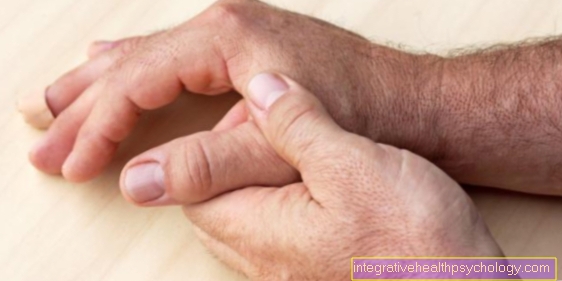Viral warts
What are viral warts?
Warts are usually benign growths on the top layers of the skin, also known as the epidermis. The Latin term for the wart is verruca. They are characterized by a sharply demarcated, flat or slightly raised growth and are possibly contagious. Most warts are caused by an infection with human papillomavirus, or HPV for short. Different strains of these viruses can be responsible for the development of the warts.
This must be distinguished from the so-called age warts and the dellar warts, which, strictly speaking, do not count as virus warts in the narrower sense. Age warts are the seborrheic warts (also called seborrheic keratoses), which occur above all from the age of 50 and represent a cornification disorder. The warts (molluscum contagiosum) mainly affect children and can be traced back to an infection with a virus from the smallpox virus family.

What viruses cause warts?
Virus warts are caused by infection with human papillomaviruses. There are over 100 different strains of this virus, which are mainly divided into so-called high- and low-risk types. The high-risk papillomaviruses are significantly involved in the development of various cancers, including cervical cancer. Low-risk papillomaviruses primarily cause viral warts.
An infection with human papillomavirus is a sexually transmitted disease, as it is mainly transmitted during sexual intercourse. More rarely, infection can also arise from a smear infection. HPV strains 1, 2, 4, 6, 10, 11, 16 and 18, as well as many others, are involved in the development of viral warts.
An exception are the so-called pelvic warts, which are not caused by human papillomaviruses but by smallpox viruses. The molluscum contagiosum virus penetrates through skin contact and is transmitted from person to person. Children and adolescents in particular are affected by this infection.
For more information, read on: Human papillomavirus.
The papillomavirus
The human papillomaviruses of the low-risk group are the main cause of viral warts. Various viruses of the more than 100 low-risk virus strains can lead to wart formation. Since an infection mainly occurs during sexual intercourse, the risk of infection increases significantly with changing sexual partners and unprotected intercourse. Condoms offer some, but not complete, protection as skin contact with an infected area can lead to transmission.
As a prophylaxis, the HPV vaccination is available, which, depending on the vaccine, protects against a certain number of HPV strains. The latest available vaccine Gardasil® covers virus strains 6, 11, 16, 18, 31, 33, 45, 52 and 58. The strains 6 and 11 are so-called low-risk viruses, which mainly cause viral warts, whereas the remaining virus strains that are covered by the vaccination belong to the cancer-causing high-risk strains.
Human papillomaviruses infect the basal cells of the skin and mucous membranes and after infection can dormant in these cells for a lifetime. Even after successful treatment, recurrences are still very common.
Read more about the topic here: Vaccination against cervical cancer.
The localization of viral warts
In the face
Certain viral warts are found primarily on the face. These include, for example, the juvenile flat warts, which mainly appear around puberty. The so-called brush warts (Verrucae filiformes) are also found primarily on the face. There they mainly settle on the eyelids, the chin and near the lips. Both juvenile flat warts and brush warts are caused by human papillomaviruses.
Furthermore, pelvic warts are preferably found on the face, especially on the eyelids. These warts are caused by the Molloscum contagiosum virus and do not count as virus warts in the strict sense.
In the genital area
The genital area is a common location for the occurrence of viral warts. An infection with human papillomaviruses, which cause the viral warts, is also one of the sexually transmitted diseases. Viral warts in the genital area should always entail co-treatment with the sexual partner, otherwise the risk of recurrence of the disease.
The well-known genital warts can be found in the genital area. Genital warts (Condylomata accuminata) are caused in particular by an infection with the human papillomavirus types 6 and 11. These are among the low-risk types and mainly cause benign skin changes. In women, genital warts can be found on the vulva, at the transition from the cervix to the vagina (portio), on the urethra (less often) and possibly in the anal area. In men, the genital warts can be found on the glans penis, foreskin, urethra and in the anal area. By practicing oral sex with infected people, genital warts can also appear in the oral mucosa. They grow in the form of beds and are dark brown in color.
The condylomata plana must be distinguished from genital warts, which are found in the same locations, but are caused by the high-risk papillomaviruses type 16 and 18. These gray-whitish warts have a high risk of degeneration.
Find out all about the topic here: Genital warts.
By the hand
The hand, especially the back of the hand, is a preferred localization for the appearance of viral warts. The vulgar warts, which are also known as common warts or barbed warts, occur mainly in adolescence, less often in adulthood. The warts are mainly caused by the papillomaviruses type 2 and 4, which are transmitted by a smear infection.
Apart from the backs of the hands, the vulgar warts also affect the fingers and the soles of the feet. The raised warts are grayish-yellow in color and have a typically rough surface. Flat warts can also be found outside of the face, especially on the wrists, backs of hands and fingers.
On the sole of the foot
The sole of the foot is very prone to the appearance of warts. Going barefoot in swimming pools, saunas or on sports fields, as well as sharing sanitary facilities and towels, promotes an infection with papilloma viruses and the development of viral warts.
Different types of warts can be found on the sole of the foot. The infestation with plantar warts, which belong to the vulgar warts, is typical. The plantar wart typically grows like a thorn into the sole of the foot due to the pressure load. The yellowish, rough surface is usually interspersed with black dots, which are small hemorrhages. They are often tender on pressure and thus impair walking. Although the plantar warts often heal on their own, they are treated anyway. Apart from the plantar warts, the mosaic warts also exist on the sole of the foot. These only spread superficially and therefore do not cause any pain.
The sole of the foot is often attacked by several warts. This can be due to either a superficial spread of the existing wart or a new infection with viruses.
On the oral mucosa
Warts can also be found in the lining of the mouth. Genital warts in particular settle there. These warts are usually found in the genital and anal area and are caused by sexual transmission of the human papillomavirus. In principle, however, these viruses can also attack mucous membranes in other parts of the body.
By having oral sex with infected people, viruses can also get into the mouth and settle there in the basal cells of the mucous membrane. These genital warts (Condylomata accuminata) grow there like beds and can, for example, be located behind the rows of teeth. The genital warts can cause uncomfortable itching.
Read more about the topic here: Human papillomaviruses.
The accompanying symptoms
Depending on the location and type of the wart, warts can lead to bothersome accompanying symptoms. Genital warts lead mainly to itching and continue to represent a cosmetic problem for many sufferers. This also applies to vulgar warts. However, the itching may also be absent.
Warts on the soles of the feet can lead to pain and thereby impair walking. This is especially the case with plantar warts, which grow like thorns into the tissue and thus have a displacing effect on the tissue.
Otherwise, warts tend to have few symptoms. They do not cause general symptoms or complaints. Occasionally, small black dots can be found on the surface of plantar warts. These are small hemorrhages.
Find out more about the topic here: Genital warts.
The diagnosis of viral warts
Both family doctors and dermatologists can make the diagnosis. The main focus is on the inspection of the skin and changes in the skin. In many cases, inspection of the warts is sufficient for the diagnosis due to their characteristic appearance and typical distribution pattern.
Especially when the genital region is affected, special HPV smears should also be carried out on men and women. In women, a vaginal examination (colposcopy) should also be performed, as infection with human papillomaviruses can also lead to cervical cancer. A virus smear from the cervix and a cell smear can be used to detect changes and infections.
If the diagnosis of a viral wart is not clear, a sample can also be taken from the suspicious skin lesion and examined under a microscope. However, this is usually not necessary.
Also read the article: Cervical cancer.
What is the best way to remove viral warts?
There are many different ways to get rid of viral warts. Depending on the location and type of wart, certain procedures are preferred to others. There is therefore no single recommended measure. In general, a distinction is made between conservative and invasive treatment options.
In conservative therapies, various drugs are applied to the wart to remove it. These are keratolytic, cytostatic, virustatic or immunomodulatory active ingredients. So-called keratolytics, such as salicylic acid or monochloroacetic acid, soften the horny layers of the wart and are applied several times a day as tinctures, ointments or as a plaster. It should not be used on the face or healthy skin.
As a cytostatic agent, 5-fluorouracil is widely used. The active ingredient kills the wart cells. Antiviral agents fight the papillomaviruses. As an ointment, the active ingredient cidofovir can be used in the treatment of genital warts or the therapy-refractory vuglar and plantar warts. The immunomodulatory active ingredient imiquimod is mainly used for local application in genital warts. With the help of liquid nitrogen, warts can also be frozen.
Aside from conservative measures, there are also invasive treatment options. Plantar warts growing very deep into the tissue can be scraped off with a so-called sharp spoon under local anesthesia. Surgical removal can also be used to treat other warts.
However, since warts often tend to recur even after successful therapy, invasive therapeutic measures are rather cautious. Aside from surgical removal, warts can also be removed with the help of laser treatment or electrocoagulation. During electrocoagulation, the cells are charred by electricity.
You can find more information at: Removal of warts.
The duration
Virus warts are unfortunately very persistent. As a rule, they do not heal by themselves and must be treated by a dermatologist. However, since human papillomaviruses persist for life in the basal cells of the skin and mucous membranes, i.e. are present, they can repeatedly lead to the formation of warts from there. The likelihood of a relapse is therefore relatively high even after successful therapy. One also speaks of a high recurrence rate.
How contagious are viral warts?
Virus warts are very contagious. Even touching the warts and the infected skin can lead to the transmission of the human papillomavirus. Many types of viruses continue to be transmitted through unprotected sex. However, there are a few things you can do to protect yourself from infection.
Nowadays it is possible to vaccinate against a certain number of viruses with the HPV vaccination.However, because there are hundreds of strains of the virus, vaccination does not offer 100% protection against papillomaviruses. Protected sexual intercourse reduces the likelihood of transmission, but also does not offer 100% protection because the viruses are also transmitted through skin contact.
One should avoid contact with warts and, if necessary, refrain from sexual intercourse if the genital area is currently affected by genital warts. In swimming pools, sports halls, fitness studios and public sanitary facilities, you should avoid going barefoot and always use your own, clean towel.
Also read the article: Are genital warts contagious?
Viral warts in children
Viral warts can appear in childhood. A common form of these viral warts are the so-called Verrucae planae juveniles. They are a special form of the Verrucae planae (flat warts) that occur mainly in children around puberty. They are mostly found on the face, but also on the back of the hand or calves. The main causes are the human papillomaviruses type 3 and 10, which are transmitted by a smear infection.
The skin-colored, soft skin changes are a cosmetic problem, especially on the face, but can also be accompanied by annoying itching. They often heal spontaneously without therapy. However, various options for therapeutic removal are also available.
Also read: Warts in children
Apart from the juvenile flat warts, the so-called dellar warts also occur mainly in childhood. These warts, also known as molluscum contagiosum, are caused by the smallpox virus and are mainly found on the eyelids, trunk, flexors and genitals. The hard skin lesions have a central dent and, under pressure, empty a sebum-like mass called molloscum pulp, which is contagious. Dellular warts can be frozen or locally removed (curetted).





























